Instrumental Instruments: Big Muff
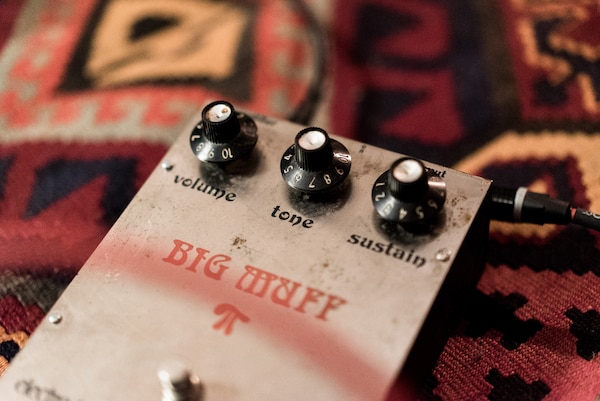
Our series on important music-making devices continues with the effect pedal that changed rock & roll forever
Mike Matthews, the brainchild behind the original Big Muff distortion pedal, has never been a guitar player. In fact, he never expected that the pedal he created would earn the vast popularity it’s enjoyed since debuting. In 1968, Matthews, then a young electrical engineer at IBM, quit his day job and teamed up with a Bell Labs inventor to create a distortion pedal that aimed to make every guitarist in the world sound like Jimi Hendrix. The New York City-based company Matthews created with a mere thousand dollars, Electro-Harmonix, soon ballooned into a global enterprise, cratered and eventually got back on its feet, forever influencing the sound of rock & roll along with it.
By his own admission, Matthews has always been a hustler. He started his first business as a child growing up in the Bronx in the 1940s, when he used hangers to fish balls out of sewers and sold them back to kids. He had a nascent interest in music – his mother began teaching him piano at age five – but quit in the fourth grade. “I was scheduled to give a concert in elementary school and I was climbing up the rafters,” Matthews remembers. “And the teacher, to punish me, canceled my concert. So I said, ‘Hell with it,’ and I quit playing the piano.”
He came back around to the keys in high school, when rock & roll was just starting, and began playing boogie-woogie style. At Cornell, Matthews started playing the electric piano and then the organ after seeing rock & roll bands live. That led to him promoting groups including the Isley Brothers, the Coasters, Chuck Berry, the Byrds and the Shirelles over summers, and he would sometimes bring bands up for spring weekend concerts. Following graduation, Matthews got several offers but decided to work at IBM, because it was in New York City. Initially, he started selling computers. But it was the ’60s then, and Matthews wanted to play the keyboard in a rock band. “Rock & roll stars...their careers were over in their young 20s,” he says. “So while I was at IBM I wanted to quit and try to play and make it. My wife at that time, she was conservative, so I wanted to make some money quick so she’d have a little security while I was off trying to make it as a keyboard player.”
As it happens, the landscape for fuzz pedals was booming at the time. “In those days there was a big, huge hit by the Stones, ‘(I Can’t Get No) Satisfaction,’” says Matthews. “It was #1 for thirteen weeks. All the guitar players wanted to buy distortion units and Maestro, the brand of the fuzztone [that Keith Richards used on the song], they couldn’t make them fast enough.”
While the likes of the Stones helped bring these warped sounds into the mainstream, these bands hardly invented tonal fuzz. The genesis of fuzz lies in guitarists including Willie Johnson, Goree Carter and Sister Rosetta Tharpe, experimenting with distortion in their sound. Fuzz is also indebted to innovations made by rock & roll progenitors such as Link Wray. Lore has it that Wray purposefully punctured a hole through the amplifier of his speakers while recording in 1958. He did this in hopes of getting a darker and more distorted sound from his guitar, and one that would accurately reflect the sound of a gang brawl; that resulted in his seminal tune “Rumble.”
While Wray’s instrumental song was banned on the airwaves (during this era of moral panic, some people thought the song’s invitation to “Rumble” might incite literal brawls), it only made burgeoning guitarists of the 1960s want to tinker with their amplifiers even more. According to Michael Hicks’ book Sixties Rock: Garage, Psychedelic and Other Satisfactions, Wray’s experimentations led the likes of Ritchie Blackmore of Deep Purple to kick holes in their speakers for the purposes of finding that fuzzed-out sound. Famously, the Kinks’ Dave Davies took a razor blade to a small amplifier’s speaker, patched it up with a bit of tape and drawing pins, then placed it on full volume and on top of his larger amp, leading to their mega-hits “You Really Got Me” and “All Day And All Of The Night” in 1964.
While fuzz and distortion often cross over, the two aren’t quite the same. Fuzz, the predecessor of distortion, has a kind of rasping effect on the ear. Distortion, which is what happens when a guitar signal is manipulated by increasing the gain, sounds like it has a bit more dirt under its fingernails. Initially bred from accidents, damaged amplifiers and experiments in turning them up past ten, distortion soon evolved into something else. “Distortion and reverb are two of the main effects because they were created out of amps, out of sounds that came from amps that people wanted to have more control over,” says Fabi Reyna, a guitarist and the editor-in-chief of She Shreds magazine. “I don’t know what it is – there’s something about distortion that has this magical quality,” says Mary Timony, the guitarist and vocalist of Helium, Ex Hex and Wild Flag. “It mushes all the sounds together and just can sound so beautiful.”
Yet Jimi Hendrix was perhaps the most important thing to happen to fuzz and distortion pedals. The story goes that in 1966, the first time that Hendrix brought out his no-frills early fuzzbox, the Arbiter Fuzz Face, in Munich, Germany, audience members were so shaken by the thick fuzz spurting out of his guitar that they yanked Hendrix offstage, in turn totaling the neck of his guitar. This then caused Hendrix to do the only thing imaginable: Smash it to pieces. The following year, the guitar company Guild rebranded the Mosrite Fuzzrite, and named it after Hendrix’s smash hit “Foxey Lady.”
Shortly afterwards, a repair man named William “Bill” Berko made Matthews a life-changing offer. At the time, Berko was tweaking fuzztone effects to meet the heightened demand and selling them at his store, ABCO Sound, located at 48th Street between 6th and 7th Avenues in Manhattan, then a hub for instrument stores and repair shops called Music Row. “[Berko] asked me, ‘Mike, you want to come in with me?’ I said, ‘OK.’ He dropped out and didn’t do anything, so I was left making those fuzztones myself,” Matthews says. With Berko out, Matthews was left to his own devices making fuzz pedals. He found a manufacturer in Queens named AUL Instruments who could help produce the pedals, which he then resold to Guild.
In early 1968, Matthews set out to build something that would help guitarists emulate Jimi Hendrix’s distinctive tone and sustain. “[Hendrix’s] thing was just with his fingers; he could make the guitar sustain just by vibrating his fingers,” he says. “I wanted to develop a distortion-free sustainer and a fellow worker at IBM, Bill Robinson, said a dude in his church – he was a Mormon – named Bob Myer was a brilliant inventor at Bell Labs, and he was looking for some work because he was going through a divorce with his wife. So I went out there, and so Bob Myer started to develop this distortion-free sustainer.”
With the Big Muff, a new musician could just pick up a guitar and easily get a Hendrix-like sustaining sound.
Things took a turn when Matthews began making one-transistor preamp boosters called the LPB-1, short for Linear Power Booster. “You could turn an amplifier up to ten and it would still be clean,” he says. “There was a lot of headroom in the amplifiers back in 1968. So this would make an amplifier much louder, but then you reached a point where it started to exceed the limit of the amp and it would overdrive and start to distort.” In order to get these preamp boosters made full-time, Matthews quit IBM, rented out a small space on 29th Street and Broadway and started Electro-Harmonix in October 1968.
He couldn’t have made the jump at a better time, and his decision to market products via mail-order started ramping up demand quickly. “The landscape for fuzz pedals was booming, and when I had the LPB-1, this simple little chassis, I looked for what else could I put in a small, little chassis,” Matthews says. “So we came out with a treble booster called the Screaming Bird and the copy was, ‘Make your guitar screech like a harpsichord whose strings are whipped instead of plucked.’ Then I came out with something called the Mole Bass Booster, that would just really roll off the high frequencies. There was another thing that gave a muffled sound, and so I called that the Muff Fuzz.”
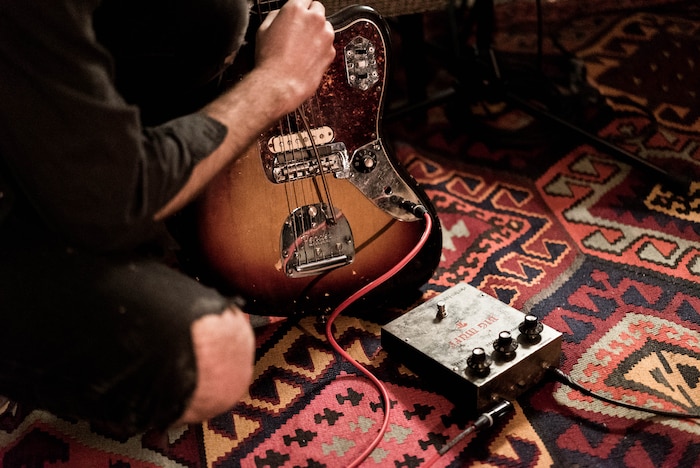
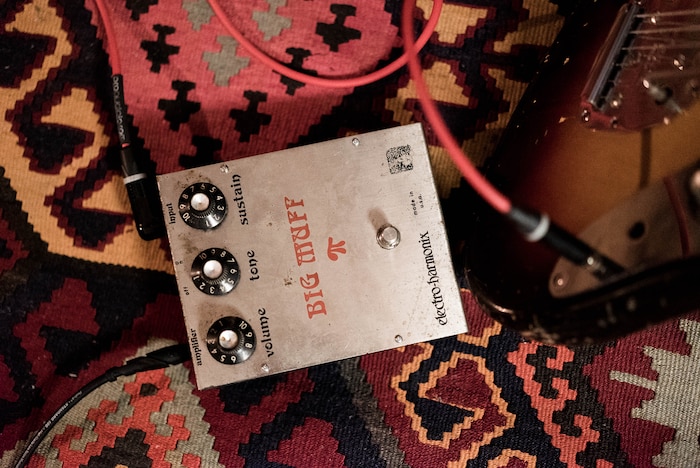
The Muff Fuzz, which Matthews describes as “a simple little overdrive that gave just a little bit of dirt,” was the predecessor to the Big Muff. The bare-bones fuzzbox featured an on/off switch and a gain control – which gave off a mighty kick, no doubt, but not quite enough. “With the Big Muff it had this cascaded circuit driving signal that would go through these sets of diodes and distort and then reamplify through the next set,” Matthews says. “As you had this compounded distortion there was more and more sustain built up. It was a little raunchy, so what I did with the Bob Myer circuit was then found different points on the circuit where I could roll off just some of the highs here, some of the highs there, so that I’d have that sweet, sweet balance between the minimal distortion but a long, sweet sustain. A new musician could just pick up a guitar and easily get a Hendrix-like sustaining sound. It was different.”
The difference paid off, and Big Muffs began flying off the shelves. Forbes estimates that by 1970 the company was raking in $300,000 in yearly sales, and Matthews calculates that he sold upwards of 3,000 Big Muffs a month in the 1970s.
Today, Electro-Harmonix boasts over a hundred unique effects pedals, ranging from slow-burning delays to wailing wah pedals and everything in between. Yet the company’s crown jewel continues to be one of the first pedals they ever put out: The Big Muff Pi. The throaty distortion pedal lives in a gray box and boasts a range of unholy sounds, thanks to a meaty sustain and throttling tone. In the 1970s, David Gilmour swore by the Big Muff sound for his solo recordings and those with Pink Floyd (The Wall and Animals especially), and Parliament-Funkadelic’s resident bass maestro Bootsy Collins has flexed the Deluxe Bass Big Muff to build his earth-shattering rhythms.
It’s likely that ’90s-era alternative rock as we know it wouldn’t have been possible without the Big Muff, either – and not just because Kurt Cobain is said to have used one in the studio on “Lithium.” The pedal had an integral role in the careful alchemy of Irish shoegaze linchpins My Bloody Valentine’s lush, layered walls of sound. For years, Sonic Youth’s Thurston Moore used the ultra-rare Sovtek Big Muff – which you can hear in the likes of the crunching “Sleepin’ Around” – and Billy Corgan’s ’70s-era Op-Amp Big Muff formed the nucleus of the Smashing Pumpkins’ Gish and Siamese Dream.
Wata, the lead guitarist of the Japanese noise trio Boris, says that the ’80s-era Big Muff she purchased in the ’90s lived on her pedalboard until the group’s 2006 album, Pink. “I was initially using distortion pedals like RAT or Marshall distortion pedal,” she says. “The thing that sort of caught me about the Big Muff was that the sustain of the pedal, I can just play one stroke of my guitar and the expression of the distortion will sort of just change automatically. In a way the Big Muff plays itself; its distortion is like a rock... rolling down the hill. It works both for chords and for single-note playing.”
I feel like it’s kind of like salt: You can use it in everything you cook, judiciously.
Bone-crushing sonic potential aside, the Big Muff bears a mythic legacy that’s unusual for effects pedals. It’s been name-checked in the likes of Depeche Mode’s eponymous 1981 tune and replicated hundreds of times over in the likes of clones and replicas. “The Big Muff...has permanent status in guitar lore and gear,” says Steve Turner, guitarist of Seattle grunge trailblazers Mudhoney, who immortalized the pedal in the title of their 1988 debut EP Superfuzz Bigmuff. “It’s gonna be one of those boxes everyone has to know about if you get into guitars. You’re gonna know about the Big Muff. I mean there’s just so many clones of it...it’s everywhere.” (Turner’s original Big Muff, which was run over by a van after a show, now sits in Seattle’s Experience Music Project Museum).
Nearly 50 years after it was invented, luminaries still marvel about the staying power of this no-nonsense pedal. “What’s so good about [the Big Muff] as well is where it feeds back,” says Oliver Ackermann, the founder of the Brooklyn-based pedals company Death By Audio and the guitarist/vocalist of A Place To Bury Strangers. “A lot of pedals, I think, designers and things were trying to stop people from doing that, and so they kind of cut off at some point, or it’s not like the transistors aren’t correctly biased to make this happen. This is a pedal which starts to, now all of a sudden, turn your instrument into something else where it has this interplay between your guitar and the amplifier.”
The interplay between instrument and amplifier – in addition to being addictively fun to experiment with – has the potential to shift dynamics within bands, too. Anna Bulbrook, the founder of the music school Girlschool and a classically-trained violinist who’s performed with the likes of Vampire Weekend and the Airborne Toxic Event, came to know her main instrument in a different way via the Big Muff. “I was plugging my violin back into my pedalboard, and I had my Big Muff in the chain,” she says. “I realized that it sounded awesome with the violin. It just turns it into this huge lead instrument. I love how much bandwidth you can take up with it; it really fills that space in a nice way. I feel like I’ve used it to make a really nice, big bed of sound for a different lead line, maybe like a higher end guitar part, or a string part to sit on top of. I’ve used it for that, too. I feel like it’s kind of like salt: You can use it in everything you cook, judiciously. It’s a very flexible ingredient.”
Despite its versatility, there’s a sort of unruliness that’s also unique to the Big Muff. It’s something that Wata remembers very clearly when she first stepped on it. “I thought it was a very wild pedal,” she says. “There was a part of it that I couldn’t control.” Yet the wiliness is a fair price to pay for its clarity, which is otherwise hard to find in distortion pedals. “This is kind of like the distortion I was always looking for, because it’s really difficult, from my experience, to find a fuzz or a distortion or an overdrive that doesn’t muddle your actual notes, where you can still hear your notes clearly but get that warm distorted sound that I’m looking for,” Fabi Reyna says. “The Big Muff did that for me in both the treble high end and low end.”
Yet it’s the Big Muff’s sustain knob, which is what invites the caustic fuzz into the mix, that’s proved to be its most resonant feature. If you turn the sustain knob all the way up – and you don’t even have to tickle the strings; a light touch will do – your trusty guitar or bass will start to growl. “It’s basically the mid-scoop kind of tone that it has, where it does have a lot of the highs, so that keeps the sustain pretty nice and long,” says Mike Hammond, who plays guitar in the Brooklyn-based groups Ovlov and Stove. “But then it also has the big bass end, so it gives the fuzz.”
Due to its balance in the ends, the Big Muff also holds a special place in the heart of many bass players. “It doesn’t get too high-end and cut through and make an unpleasant sound to the ears,” says Troy Sanders, who plays bass in Atlanta metal pioneers Mastodon. “It’s just the thickest, purest, roundest, warmest, most glorious bass distortion sound that I’ve ever had.” The Big Muff also holds a curious position in guitar history: It’s a gold standard as far as distortion pedals go, but it also serves as a barrier-breaker to get into other kinds of effects, too. “That is the gateway sonic drug that’s now got me addicted to pedals,” Sanders laughs. “I don’t blame myself, I blame the Big Muff. I blame the green, Russian-made Big Muff for all my problems and successes.”
What’s amazing is this pedal is one of the earlier distortion pedals that was ever made and they’re still made to this day.
Electro-Harmonix has gone through its fair share of shake-ups, too. Expansion happened quickly in the 1970s, but by the 1980s Matthews was spread thin. He ended up selling the Electro-Harmonix trademark in 1984 and lived off a royalty he made when he sold audio delay technology to Akai, of Japan. Four years later, he started building integrated circuits and vacuum tubes in Russia, then bought the name Electro-Harmonix back in 1990 and started making Electro-Harmonix pedals out of a small military factory in St. Petersburg. The Russian pedals are ultra-rare these days, and some impassioned gearheads dispute that they sound even better than the original Big Muff Pi.
Speaking of Pi, the pedal’s name has also been a factor in its continued infamy. Matthews makes no bones about the fact that the pedal’s name has less-than-stellar origins. “I called it the Big Muff to play off the name of the Muff that was already established, and I threw in the Pi just as a goof because it was kind of like a derogatory thing...this is the ’60s and anything goes,” he says. The name hasn’t exactly aged well. But the many women-identifying guitar and bass players out there who continue innovating with the pedal are undeterred by its disparaging origins. “That’s amazing because of the fucking power that comes from that pedal,” says Reyna. “I love the pedal for having such a cheeky name,” Bulbrook says. “Even though understanding it comes from a very gendered name...it doesn’t bother me, really. So many more mountains to die on out there than this particular one.”
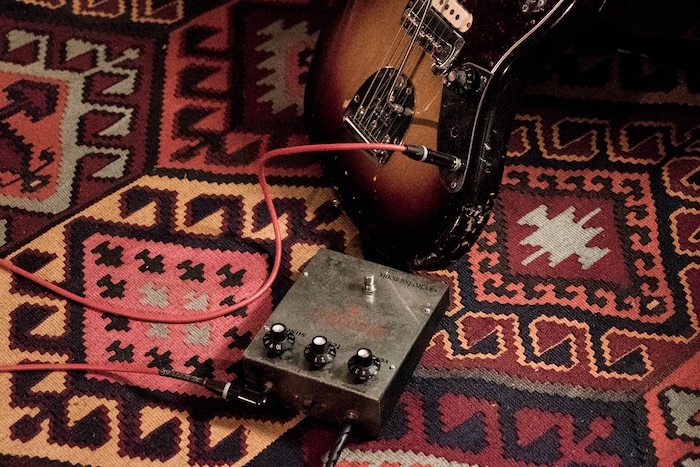
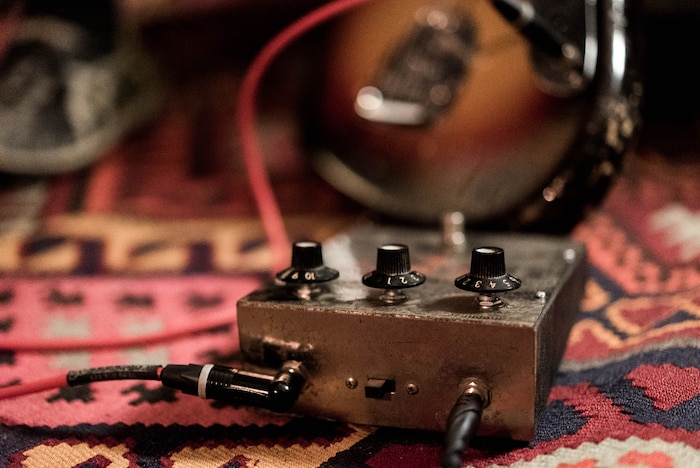
However people feel about the name, Big Muff continues to loom large today in the ever-widening universe of effects pedals, too, which aren’t just being made by big companies anymore (though Electro-Harmonix is still very much in business, and they’re even reissuing said Russian Big Muff in a couple of months). Boutique pedals made by the likes of Death By Audio, Earthquaker and Frantone are renowned for their designs and unusual effects, and more and more people are manufacturing their own plays on the Big Muff.
While the Big Muff was by no means the first effect pedal in existence, it changed the direction of music, as well as the kinds of tools people use to make it. “What’s amazing is this pedal is one of the earlier distortion pedals that was ever made and they’re still made to this day,” Ackermann says, particularly highlighting the influence the Big Muff has had on his own pedal-making at Death By Audio. “I think this has been such a big influence on people to have a pedal that they can buy that takes their sound to this really loud and crazy place. It sort of embraces that ferocity and things that’s in rock & roll, and music. That’s something that, as a designer of anything, whether it be clothing or artwork or whatever you do, you get to set up what are the tools that people are going to use, or what are people going to see when they walk down the street, or what are people going to be talking about. You have that artistic control. This is something which got people to play louder and fuzzier and crazier, and we take that into consideration with every sort of design that we do.”
Header image © Maxwell Schiano
